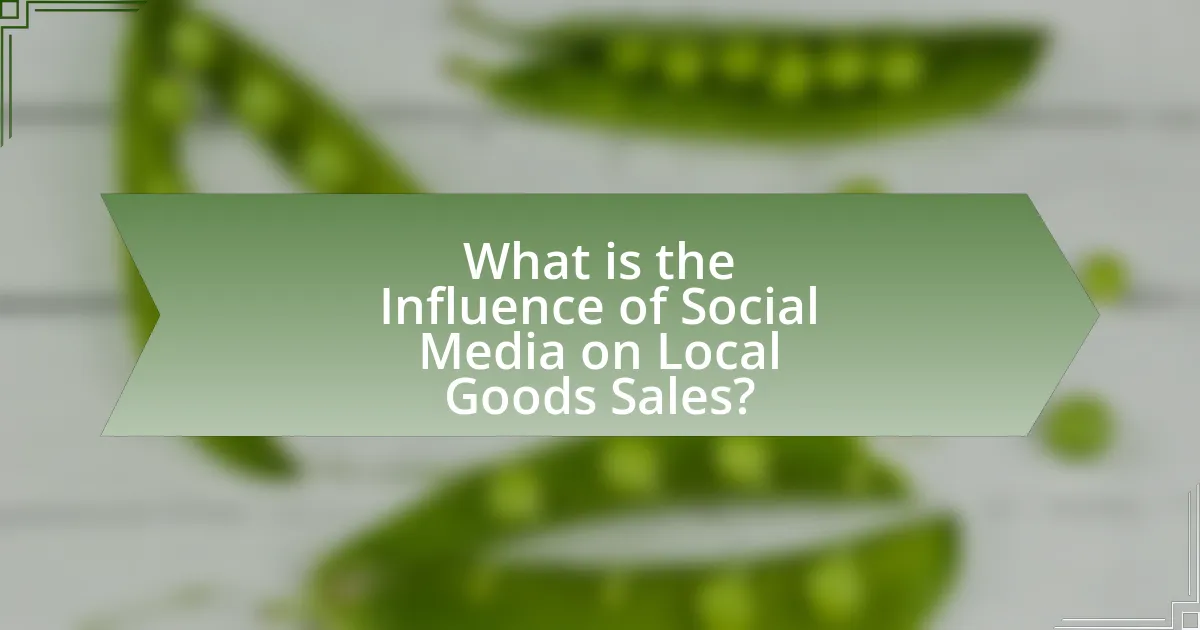The article examines the significant influence of social media on local goods sales, highlighting how platforms like Facebook and Instagram enhance visibility and consumer engagement for local businesses. It discusses the impact of user-generated content and reviews on purchasing decisions, emphasizing the importance of social media marketing in fostering community connections and driving sales. Key strategies for leveraging social media, such as targeted advertising and community engagement, are outlined, along with metrics for measuring effectiveness and common challenges faced by local businesses in this digital landscape. The article also addresses emerging trends and best practices for maintaining relevance and building customer loyalty through effective social media use.

What is the Influence of Social Media on Local Goods Sales?
Social media significantly boosts local goods sales by enhancing visibility and engagement with potential customers. Platforms like Facebook and Instagram allow local businesses to showcase their products, reach targeted audiences, and foster community connections. According to a study by the Pew Research Center, 69% of adults in the U.S. use social media, which increases the likelihood of local consumers discovering and purchasing from nearby businesses. Additionally, a report from Hootsuite indicates that 54% of social media users utilize these platforms to research products before making a purchase, demonstrating the direct impact of social media on consumer behavior and local sales.
How does social media impact consumer behavior regarding local goods?
Social media significantly influences consumer behavior regarding local goods by enhancing visibility and fostering community engagement. Platforms like Instagram and Facebook allow local businesses to showcase their products, leading to increased awareness and interest among consumers. According to a 2021 survey by Sprout Social, 79% of consumers reported that user-generated content on social media influenced their purchasing decisions, particularly for local products. This engagement not only drives sales but also builds a sense of community around local brands, encouraging consumers to support their local economy.
What role do social media platforms play in promoting local goods?
Social media platforms play a crucial role in promoting local goods by providing businesses with a direct channel to engage with their community and target audience. These platforms enable local businesses to showcase their products, share promotions, and connect with customers through targeted advertising and organic reach. For instance, a study by the Pew Research Center found that 69% of adults in the U.S. use social media, which allows local businesses to tap into a vast audience and increase visibility. Additionally, social media facilitates user-generated content, where customers can share their experiences and reviews, further enhancing the credibility and appeal of local goods. This interactive environment fosters community support and drives sales, as consumers are more likely to purchase from businesses they feel connected to.
How do user-generated content and reviews affect local goods sales?
User-generated content and reviews significantly enhance local goods sales by building trust and influencing consumer purchasing decisions. Research indicates that 79% of consumers trust online reviews as much as personal recommendations, which directly impacts their likelihood to buy local products. Positive user-generated content can increase sales by up to 18%, as it creates a sense of community and authenticity around local brands. Additionally, platforms like Yelp and Google Reviews show that businesses with higher ratings and more reviews experience increased foot traffic and sales, demonstrating the direct correlation between user-generated content and local goods sales.
Why is social media marketing important for local businesses?
Social media marketing is important for local businesses because it enhances visibility and engagement within the community. By utilizing platforms like Facebook, Instagram, and Twitter, local businesses can directly reach their target audience, fostering relationships and encouraging customer loyalty. According to a survey by the Pew Research Center, 69% of adults in the U.S. use social media, making it a crucial channel for local businesses to connect with potential customers. Additionally, social media allows for cost-effective advertising, enabling local businesses to promote their products and services to a geographically targeted audience, which can lead to increased foot traffic and sales.
What advantages do local businesses gain from using social media?
Local businesses gain increased visibility and customer engagement from using social media. By establishing a presence on platforms like Facebook and Instagram, these businesses can reach a broader audience, as 73% of marketers believe that their efforts through social media have been “somewhat effective” or “very effective” for their business. Additionally, social media allows for direct interaction with customers, fostering community relationships and encouraging customer loyalty. According to a survey by Sprout Social, 64% of consumers want brands to connect with them on social media, highlighting the importance of engagement in driving sales and brand loyalty.
How can social media enhance brand visibility for local goods?
Social media enhances brand visibility for local goods by providing a platform for targeted marketing and community engagement. Local businesses can utilize social media to reach specific demographics within their geographic area, increasing awareness and interest in their products. For instance, platforms like Facebook and Instagram allow businesses to create localized ads that can be seen by users in their vicinity, effectively promoting local goods to potential customers. According to a study by the Pew Research Center, 69% of adults in the U.S. use social media, making it a vital channel for local businesses to connect with their audience. Additionally, user-generated content and customer reviews shared on social media can amplify brand visibility, as positive experiences can be quickly disseminated among local networks, further enhancing the reputation and reach of local goods.

What are the key strategies for leveraging social media in local goods sales?
Key strategies for leveraging social media in local goods sales include targeted advertising, community engagement, and user-generated content. Targeted advertising allows businesses to reach specific demographics within their local area, increasing the likelihood of sales; for instance, Facebook Ads can be tailored to users based on location, interests, and behaviors. Community engagement fosters relationships with local customers through interactive posts, local events, and responding to comments, which builds brand loyalty and trust. User-generated content, such as customer reviews and photos, serves as authentic endorsements that can influence potential buyers; studies show that 79% of consumers trust online reviews as much as personal recommendations. These strategies collectively enhance visibility and drive sales for local goods through effective social media utilization.
How can local businesses effectively engage with their audience on social media?
Local businesses can effectively engage with their audience on social media by creating authentic, relevant content that resonates with their community. This involves sharing local news, promoting events, and showcasing customer stories to foster a sense of connection. According to a study by Sprout Social, 70% of consumers feel more connected to brands that use social media to engage with them, highlighting the importance of interaction. Additionally, responding promptly to comments and messages enhances customer relationships, as 53% of consumers expect brands to respond within an hour. By utilizing targeted advertising and local hashtags, businesses can reach specific demographics, further increasing engagement and driving local sales.
What types of content resonate most with consumers of local goods?
Visual content, particularly high-quality images and videos showcasing local goods, resonates most with consumers of local products. This type of content effectively highlights the uniqueness and craftsmanship of local items, fostering a connection between the consumer and the product. Research indicates that posts featuring vibrant visuals receive 94% more views than text-only content, emphasizing the importance of visual appeal in engaging consumers. Additionally, storytelling content that shares the origin and background of local goods enhances emotional engagement, as consumers are increasingly drawn to brands that reflect their values and community ties.
How can local businesses utilize social media advertising to boost sales?
Local businesses can utilize social media advertising to boost sales by targeting specific demographics and engaging with their community through tailored content. By using platforms like Facebook and Instagram, businesses can create ads that reach local consumers based on location, interests, and behaviors, which increases the likelihood of conversion. For instance, a study by Hootsuite found that 73% of marketers believe that their efforts through social media advertising have been “somewhat effective” or “very effective” in achieving their business goals. Additionally, local businesses can leverage user-generated content and customer testimonials in their ads to build trust and encourage purchases, as 79% of consumers say user-generated content highly impacts their purchasing decisions.
What metrics should local businesses track to measure social media effectiveness?
Local businesses should track engagement rate, reach, conversion rate, and follower growth to measure social media effectiveness. Engagement rate indicates how well content resonates with the audience, calculated by dividing total interactions (likes, comments, shares) by total followers. Reach measures the number of unique users who see posts, providing insight into brand visibility. Conversion rate tracks the percentage of users who take a desired action, such as making a purchase after engaging with social media content, which is crucial for assessing ROI. Follower growth reflects the increase in audience size over time, indicating brand interest and potential market expansion. These metrics collectively provide a comprehensive view of social media performance and its impact on local goods sales.
Which key performance indicators are most relevant for local goods sales?
The key performance indicators most relevant for local goods sales include sales volume, customer acquisition cost, average transaction value, and customer retention rate. Sales volume measures the total quantity of goods sold, providing insight into market demand and business performance. Customer acquisition cost indicates the expense incurred to attract new customers, which is crucial for evaluating marketing effectiveness. Average transaction value reflects the average amount spent per transaction, helping businesses understand purchasing behavior. Customer retention rate assesses the percentage of repeat customers, highlighting customer loyalty and satisfaction. These indicators collectively offer a comprehensive view of local goods sales performance, enabling businesses to make informed decisions.
How can businesses analyze consumer engagement on social media?
Businesses can analyze consumer engagement on social media by utilizing analytics tools that track metrics such as likes, shares, comments, and overall reach. These tools, such as Facebook Insights and Twitter Analytics, provide quantitative data that helps businesses understand how their content resonates with audiences. For instance, a study by Sprout Social found that posts with images receive 650% more engagement than text-only posts, highlighting the importance of visual content in driving interaction. By regularly monitoring these metrics, businesses can adjust their strategies to enhance engagement and ultimately influence local goods sales.

What challenges do local businesses face in using social media for sales?
Local businesses face several challenges in using social media for sales, primarily including limited resources, lack of expertise, and competition. Limited resources often hinder small businesses from investing in effective social media marketing strategies, as they may not have dedicated staff or budget for advertising. A study by the Small Business Administration indicates that 70% of small businesses allocate less than 10% of their budget to marketing, which includes social media efforts.
Additionally, many local businesses lack the expertise needed to navigate the complexities of social media platforms, leading to ineffective campaigns. According to a survey by Hootsuite, 54% of small business owners feel overwhelmed by the demands of social media marketing.
Finally, competition from larger brands and other local businesses intensifies the challenge, as they often have more resources and established online presences. Research from the Pew Research Center shows that 69% of adults use social media, making it a crowded space where local businesses must work harder to stand out.
What are common pitfalls local businesses encounter on social media?
Local businesses commonly encounter pitfalls on social media such as inconsistent branding, lack of engagement, and failure to analyze performance metrics. Inconsistent branding can confuse customers and dilute brand identity, leading to reduced recognition and trust. Lack of engagement results in missed opportunities to build relationships with customers, as businesses may not respond to comments or messages, which can negatively impact customer loyalty. Additionally, failure to analyze performance metrics prevents businesses from understanding what content resonates with their audience, hindering their ability to optimize future posts and campaigns. According to a survey by Hootsuite, 60% of businesses do not track their social media performance, which illustrates the prevalence of this issue.
How can local businesses overcome negative feedback on social media?
Local businesses can overcome negative feedback on social media by actively engaging with customers, addressing concerns promptly, and demonstrating a commitment to improvement. Engaging with customers involves responding to negative comments in a professional and empathetic manner, which can help to diffuse tension and show that the business values customer feedback. Addressing concerns promptly is crucial; studies indicate that 70% of customers expect a response within 24 hours, and timely responses can mitigate the impact of negative reviews. Demonstrating a commitment to improvement can include implementing changes based on feedback and communicating these changes to the audience, which can enhance the business’s reputation and rebuild trust.
What strategies can mitigate the impact of social media algorithm changes?
To mitigate the impact of social media algorithm changes, businesses should diversify their content distribution channels. Relying solely on one platform can lead to significant losses when algorithms shift, as seen when Facebook altered its news feed algorithm in 2018, resulting in a 50% drop in organic reach for many brands. By utilizing multiple platforms such as Instagram, Twitter, and email marketing, businesses can maintain visibility and engagement regardless of changes on any single platform. Additionally, investing in building an email list allows for direct communication with customers, independent of social media algorithms. This strategy not only enhances customer loyalty but also ensures that businesses can reach their audience effectively, even amidst algorithm fluctuations.
How can local businesses adapt to changing social media trends?
Local businesses can adapt to changing social media trends by actively engaging with their audience through tailored content and utilizing emerging platforms. By analyzing user behavior and preferences, businesses can create relevant posts that resonate with their target demographic, thereby increasing engagement rates. For instance, according to a 2022 Sprout Social report, 70% of consumers are more likely to purchase from brands that engage with them on social media. Additionally, local businesses should leverage features like live streaming and stories on platforms such as Instagram and TikTok, which have seen significant user growth, to showcase products and connect with customers in real-time. This approach not only enhances visibility but also fosters community relationships, crucial for local market success.
What emerging trends should local businesses be aware of in social media marketing?
Local businesses should be aware of the trend towards increased use of short-form video content in social media marketing. Platforms like TikTok and Instagram Reels have shown that short, engaging videos can significantly boost user engagement and brand visibility. According to a report by HubSpot, 54% of consumers want to see more video content from brands they support, indicating a strong preference for this format. Additionally, the rise of social commerce, where social media platforms integrate shopping features, allows local businesses to sell directly through their social media profiles, streamlining the purchasing process for consumers. This trend is supported by a study from eMarketer, which found that social commerce sales in the U.S. are expected to reach $36.09 billion by 2021, highlighting the growing importance of social media as a sales channel for local businesses.
How can businesses stay relevant in a rapidly evolving social media landscape?
Businesses can stay relevant in a rapidly evolving social media landscape by continuously adapting their strategies to align with emerging trends and consumer behaviors. This involves actively monitoring social media platforms for changes in algorithms, user preferences, and popular content formats. For instance, a report by Hootsuite indicates that 54% of social media users prefer video content, prompting businesses to incorporate more video marketing into their strategies. Additionally, engaging with audiences through interactive content, such as polls and live streams, fosters community and loyalty, which is essential for maintaining relevance. By leveraging analytics tools to track engagement metrics, businesses can refine their approaches based on real-time feedback, ensuring they meet the evolving expectations of their target market.
What best practices should local businesses follow for successful social media marketing?
Local businesses should focus on creating engaging, relevant content tailored to their target audience for successful social media marketing. This involves understanding the local community’s interests and preferences, which can be achieved through surveys or social listening tools. Additionally, maintaining a consistent posting schedule enhances visibility and engagement, as studies show that brands posting regularly see a 50% increase in audience interaction. Utilizing local hashtags and geotags can further increase reach, as posts with location tags receive 79% more engagement. Finally, responding promptly to customer inquiries and comments fosters community trust and loyalty, which is crucial for local businesses aiming to build long-term relationships with their customers.
How can local businesses create a consistent brand voice on social media?
Local businesses can create a consistent brand voice on social media by establishing clear brand guidelines that define tone, language, and messaging. These guidelines should reflect the business’s values and target audience, ensuring that all posts resonate with the intended demographic. For instance, a study by Sprout Social indicates that 70% of consumers feel more connected to brands with a consistent voice, which can enhance customer loyalty and engagement. By regularly reviewing and updating their content strategy in alignment with these guidelines, local businesses can maintain a cohesive presence across various platforms, ultimately driving sales and brand recognition.
What are effective ways to build a loyal community around local goods?
Effective ways to build a loyal community around local goods include fostering strong relationships through engagement, promoting transparency, and utilizing social media platforms for outreach. Engaging with customers through events, workshops, and local markets creates personal connections, which enhances loyalty. Transparency about sourcing and production processes builds trust, as consumers increasingly prefer brands that align with their values. Social media platforms, such as Instagram and Facebook, allow for targeted marketing and community interaction, enabling local businesses to showcase their products and share customer stories, which can lead to increased brand loyalty. According to a study by the American Marketing Association, brands that actively engage with their communities on social media see a 20% increase in customer loyalty.




